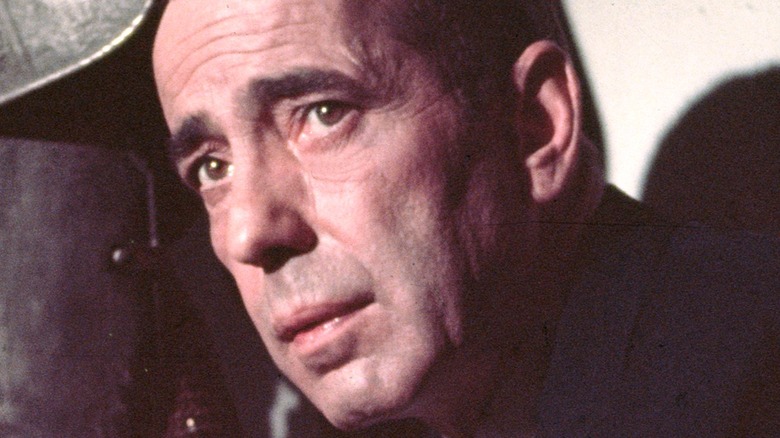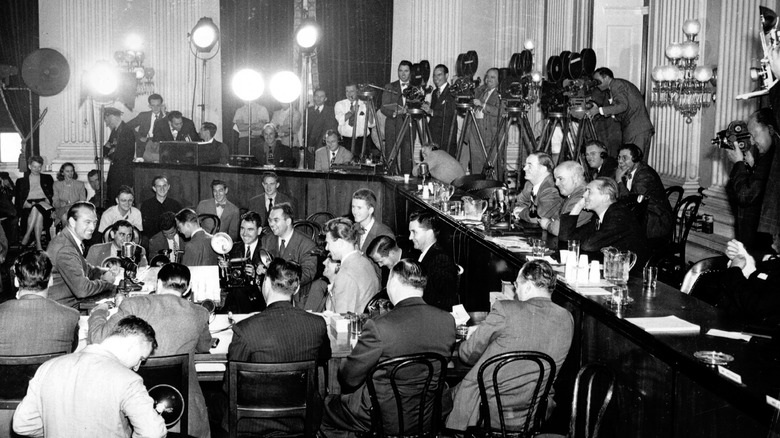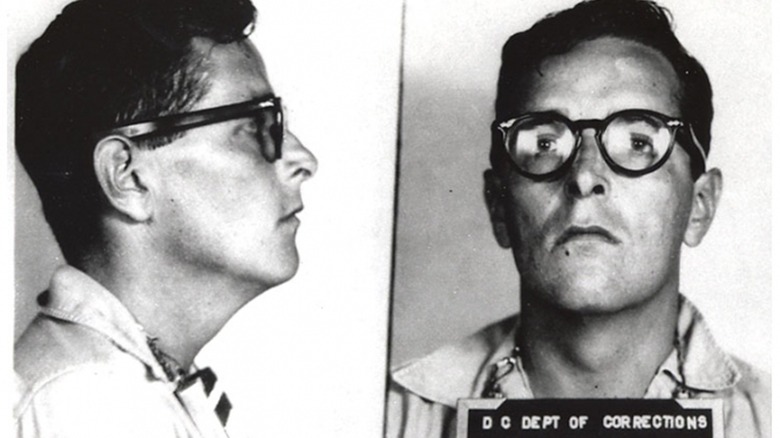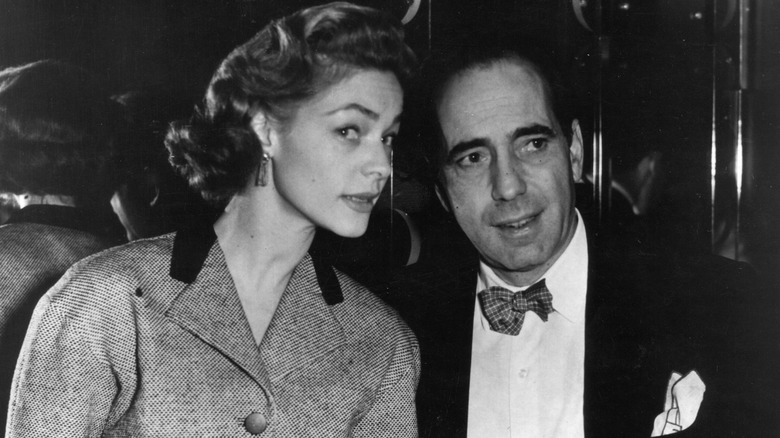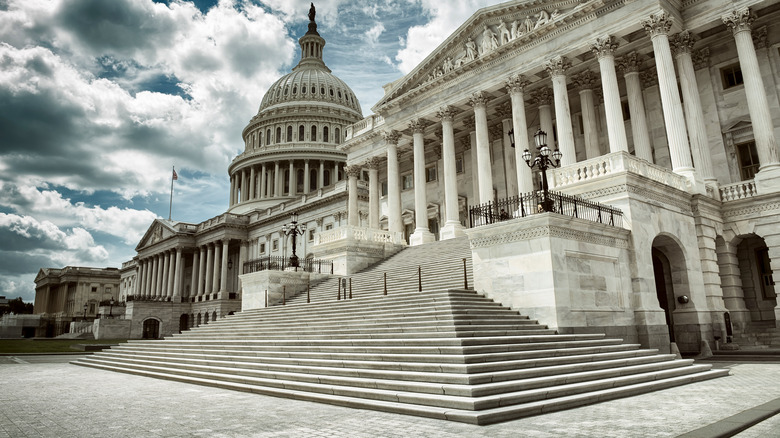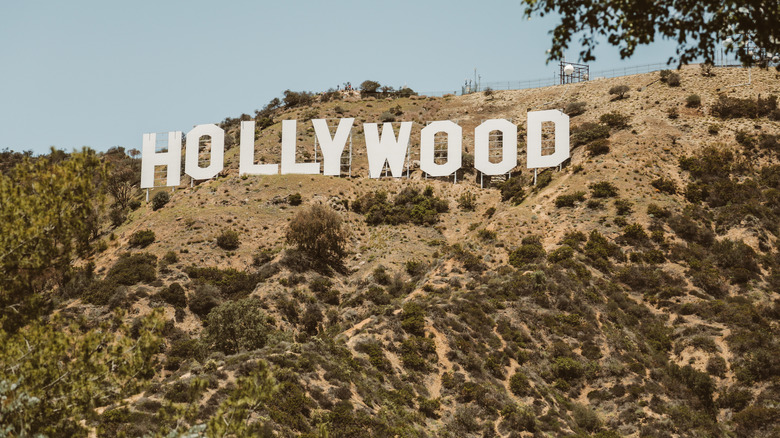How Humphrey Bogart Took A Stand During The Hollywood Red Scare
Humphrey Bogart, his new wife Lauren Bacall, and more than 20 other Hollywood personalities, sat in a hearing room on Capitol Hill in Washington, D.C. as a red-faced J. Parnell Thomas, a New Jersey Republican Congressperson, banged his gavel and had John Howard Lawson brought up on a charge of contempt of Congress. This charge was levied for refusing to answer questions about whether he was a communist, according to the Associated Press. It was October 27, 1947, and Bogart and the others, members of a new organization, the Committee for the First Amendment, had just flown in from California to attend the House Un-American Activities Committee then amid their witch hunt for communists in Hollywood, per Slate.
Bogart and the others weren't pro-communist. They were defenders of the First Amendment there to support the rights of their fellow Hollywood coworkers to hold whatever views they wished, per Quartz. But in the overheated atmosphere in the United States of the late 1940s, just as the Cold War with the Soviet Union was beginning, parsing out these distinctions made little difference. Bogart, Bacall, and the others put their careers and potentially their freedom on the line to protest an overreaching government committee that cared little about destroying the lives and reputations of some of the greatest writers and directors of Hollywood's Golden Age.
What Was HUAC?
By the time the House Un-American Activities Committee began its hearings in D.C. involving Hollywood, it had already existed for nine years and had become a powerful political tool often used to settle personal scores and a way to advance legislative careers. Launched in 1938, the committee looked into alleged disloyalty and subversive activity of private citizens, public employees, and organizations, per the Harry S. Truman Library.
HUAC's tactics quickly earned it scorn from President Franklin D. Roosevelt, who denounced the committee for giving "a forum to those who, for political purposes...seek headlines which they could not otherwise obtain," per the Associated Press. The film director John Huston pointed out in 1947, that in nine years HUAC had "spent millions of dollars of taxpayers' money" and "proposed exactly one piece of legislation and that was rejected as unconstitutional," per the "Hollywood Fights Back" radio broadcast. Still, during the Cold War, HUAC held sway over public opinion and newspaper headlines and in the fall of 1947 its sites were squarely on Hollywood.
Who Were the Hollywood 10?
Jack Warner, the head of Warner Brothers, the studio to whom Humphrey Bogart was under contract, was the first witness to appear before HUAC. He did so willingly and named people in Hollywood he believed might be communists, per Slate. Other "friendly witnesses," as the press dubbed those willing to testify before HUAC, included Ronald Reagan, then head of the Screen Actors Guild of America, and Walt Disney, who used the committee to hit back at his animators who'd been involved in a recent strike, according to The Archive. The "friendly witnesses" named 19 people with left-wing views.
The press termed these 19 witnesses, who the committee subpoenaed for the hearings, the "Unfriendly 19" with 10 of the directors, screenwriters and producers labeled "The Hollywood 10," per Britannica. These men, including the authors and screenwriters Ring Lardner Jr. and Dalton Trumbo, refused to answer questions about their political affiliations and denounced the committee for trampling on their rights, per History.
Humphrey Bogart Took His Cues from Lauren Bacall
It was Lauren Bacall who pushed Humphrey Bogart towards a more left-leaning worldview, according to the novelist and friend of the couple, Clancy Sigal, writing in The New Republic. Bacall was just starting out her film career and had been married to Bogart for just two years, per Biography. Bacall was a "true-blue New York left-of-center liberal Democrat" who helped shore up Bogart's "political backbone," according to Sigal.
In the fall of 1947, Bacall convinced her husband to join a non-political organization dedicated to preserving the rights to free speech and assembly named the Committee for the First Amendment, according to Slate. They were in good company. The committee held its first meeting at the composer Ira Gershwin's house with everyone from Groucho Marx to Rita Hayworth to Gene Kelly in attendance. The initial statement put out by the committee, which didn't list either Bogart or Bacall as signatories, stated "as American citizens who believe in constitutional democratic government" they were "disgusted and outraged by the continuing attempt of the House Committee on Un-American Activities to smear the Motion Picture Industry," per the National Archives' DocsTeach website.
Bogie and Bacall Go to Washington
That fall, Humphrey Bogart became the lead spokesperson for the group, putting out press statements bashing HUAC's tactics. In October, ABC aired a radio program called "Hollywood Fights Back," featuring a who's who of the entertainment world, including Judy Garland, the big-band leader Artie Shaw, and Lucille Ball, among more than 40 others, per the radio broadcast on YouTube. Both Bacall and Bogart also took part in the program. "Is democracy so feeble it can be subverted by merely a look or a line, an inflection, a gesture?" Bogart asked before stating HUAC wasn't "empowered to dictate what Americans shall think," per the broadcast.
The same day the radio show aired, the contingent of A-list Hollywood bigwigs flew to Washington. Once there, they had photo ops, attended the hearings, and filed a "petition for redress of grievances" with the House of Representatives that stated that HUACs procedures "have persistently violated the civil liberties of American citizens" and "smeared" the reputations of many people through "guilt by association," per the Associated Press. The trip didn't have the effect Bogart and the others had hoped. In fact, it was a PR disaster, according to Thomas Patrick Doherty's book "Show Trial: Hollywood, HUAC, and the Birth of the Blacklist."
The Fallout From Hollywood's Stance Against HUAC
The first day Humphrey Bogart and the other Hollywood heavy hitters, dubbed the "glamour brigade" by the press (per "Show Trial"), attended the hearing, John Howard Lawson was on the stand. Lawson was a playwright, screenwriter, and a founder of the Screen Writers Guild, who was also a communist, according to The Hollywood Reporter. He and HUACs chairperson, J. Parnell Thomas, got into a shouting match that didn't play well with the public, according to "Show Trial." In the exact scenario the Committee for the First Amendment had railed against, they too suffered from "guilt by association."
Before his Washington trip, Bogart told the press, "This has nothing to do with communism. It's none of my business who's a communist and who isn't," per Slate. But once back in Hollywood, both he and Bacall came under an intense pressure campaign by the government, Warner Brothers studio, and his agents, to backtrack on their stance against HUAC, per Clancy Sigal in The New Republic. In December 1947, Bogart gave a press statement in which he disavowed any communist leanings, per The Commercial Appeal. The next May, Bogart again came out against communism in Photoplay, but defended liberals and the right to call out government censorship. He and Bacall continued their film careers. The Hollywood 10, on the other hand, were given jail sentences ranging from six months to a year, and blacklisted by the studio bosses, with many never working in Hollywood again, per Britannica.
